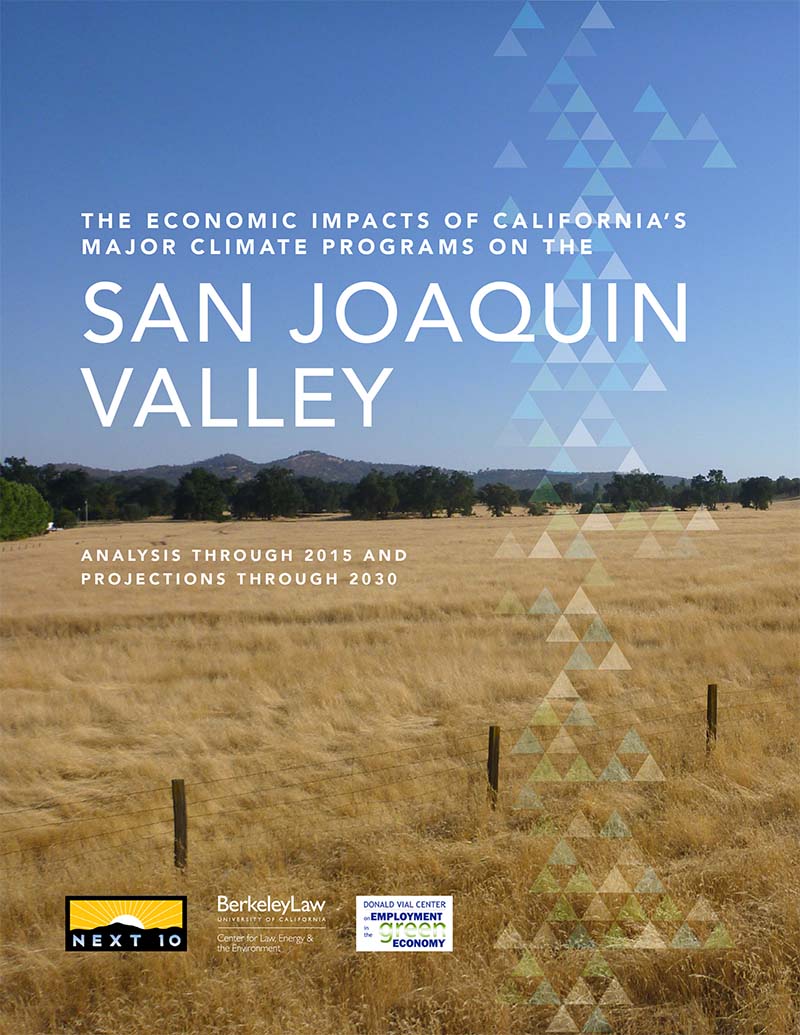January 2017
 Amid concerns about the economic and employment impacts of California’s ambitious climate policies, CLEE and its research partners have conducted the first comprehensive, academic study of the costs and benefits of these policies on the San Joaquin Valley. Together with UC Berkeley’s Donald Vial Center on Employment in the Green Economy, and working with the nonpartisan nonprofit Next 10, we found a total economic benefit of $13.4 billion in the Valley including the creation of tens of thousands of jobs.
Amid concerns about the economic and employment impacts of California’s ambitious climate policies, CLEE and its research partners have conducted the first comprehensive, academic study of the costs and benefits of these policies on the San Joaquin Valley. Together with UC Berkeley’s Donald Vial Center on Employment in the Green Economy, and working with the nonpartisan nonprofit Next 10, we found a total economic benefit of $13.4 billion in the Valley including the creation of tens of thousands of jobs.Key Findings
Cap & Trade
The study found that industries benefiting from the investment of cap-and-trade revenue, such as construction, generate more economic activity in the region than those industries bearing the costs of cap-and-trade compliance. Our research shows that:
- After accounting for compliance and other costs the cap-and-trade program had direct economic benefit of $119 million to the San Joaquin Valley, and boosted the economy by $200 million when you include indirect and induced economic benefits.
-
There was a potential negative impact on 400 jobs due to compliance from 2013 through 2015, but on a net basis, more than 700 jobs were created directly, and more than 1,600 supporting service and industry jobs were created indirectly, in the same period.
-
State and local tax revenues received a $4.7 million boost in this time frame as result of cap-and-trade.
Renewables Portfolio Standard (RPS)
While more attention is often paid to the state’s carbon cap-and-trade program, in terms of the San Joaquin Valley’s economy, the state’s Renewables Portfolio Standard (RPS) has had a bigger impact so far:
- Construction on renewable-energy projects has resulted in $11.6 billion in total economic activity in the Valley.
- From 2002 to 2015, renewable programs created about 31,000 direct jobs in the San Joaquin Valley — for people building and operating renewable-energy facilities, for example — and created another 57,000 indirect and induced jobs for suppliers, supporting businesses and the like, for a total of 88,000 jobs.
Energy Efficiency Programs
The report finds that energy efficiency programs overseen by the California Public Utilities Commission (CPUC) are cost-efficient vehicles for families, businesses and institutions to save energy and money year after year. By cutting demand, efficiency efforts also reduce the need for costly new power-generating infrastructure. Our analysis shows that:
-
Energy efficiency programs in the Valley have provided net economic benefits of $248 million since 2010.
- From 2006 to 2015, utility energy efficiency programs created 6,700 direct jobs, two-thirds of them in the construction industry and 10,700 indirect and induced jobs in the Valley, for a total of 17,400 jobs.
Policy Recommendations
Given the economic benefits of California’s climate policies in the San Joaquin Valley, we offer recommendations for maintaining and improving results as the state moves to further climate policies under SB 32 and SB 350:
- Work to remove the legal uncertainty about the cap-and-trade program by extending the allowance auction mechanism beyond 2020
- Ensure that cap-and-trade auction proceeds are spent on Valley programs that cut greenhouse gas emissions and co-pollutants
- Expand energy efficiency incentives in the Valley, where they yield greater energy savings than in more temperate parts of the state
- Develop robust transition programs for workers and communities affected by the decline of the region’s greenhouse gas-emitting industries
Download the Report:
The Economic Impacts of California’s Major Climate Programs on the San Joaquin Valley (Jan 2017)
See Our Op-Ed in the Sacramento Bee:
State Climate Policies are Boosting San Joaquin Valley’s Economy (Jan 20, 2017)
Review our Webinar Discussion:
Media Coverage
CVBT Interview
For More Information:
Contact Ethan Elkind, Director, Climate Program, Center for Law, Energy & the Environment at UC Berkeley Law